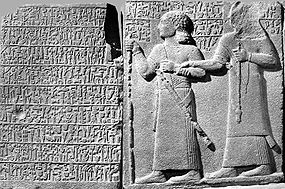
Register (sculpture)
Encyclopedia

Common examples are from Ancient Egypt
Ancient Egypt
Ancient Egypt was an ancient civilization of Northeastern Africa, concentrated along the lower reaches of the Nile River in what is now the modern country of Egypt. Egyptian civilization coalesced around 3150 BC with the political unification of Upper and Lower Egypt under the first pharaoh...
ian hieroglyphs
Egyptian hieroglyphs
Egyptian hieroglyphs were a formal writing system used by the ancient Egyptians that combined logographic and alphabetic elements. Egyptians used cursive hieroglyphs for religious literature on papyrus and wood...
as decoration scenes, on objects.
Luwian language
Luwian language
Luwian is an extinct language of the Anatolian branch of the Indo-European language family. Luwian is closely related to Hittite, and was among the languages spoken during the second and first millennia BC by population groups in central and western Anatolia and northern Syria...
hieroglyphs were also represented in stone art, in registers. Another example, in Mesopotamian art, would be the stones called Kudurru
Kudurru
Kudurru was a type of stone document used as boundary stones and as records of land grants to vassals by the Kassites in ancient Babylonia between the 16th and 12th centuries BCE. The word is Akkadian for "frontier" or "boundary"...
, or boundary stones, which often had registers of god
God
God is the English name given to a singular being in theistic and deistic religions who is either the sole deity in monotheism, or a single deity in polytheism....
s on the upper registers of the scenes.

See also
- Luwian languageLuwian languageLuwian is an extinct language of the Anatolian branch of the Indo-European language family. Luwian is closely related to Hittite, and was among the languages spoken during the second and first millennia BC by population groups in central and western Anatolia and northern Syria...
- KudurruKudurruKudurru was a type of stone document used as boundary stones and as records of land grants to vassals by the Kassites in ancient Babylonia between the 16th and 12th centuries BCE. The word is Akkadian for "frontier" or "boundary"...
- Libyan PaletteLibyan PaletteThe Libyan Palette is the surviving lower portion of a stone cosmetic palette bearing carved decoration and writing. It dates from the Naqada III or Protodynastic Period of Egypt...
, (external link 2)
Former link 1, had 3 registers of Marching animals.
External links
- Louvre block statue of Wahibre-(Wah,ib,re) LouvreLouvreThe Musée du Louvre – in English, the Louvre Museum or simply the Louvre – is one of the world's largest museums, the most visited art museum in the world and a historic monument. A central landmark of Paris, it is located on the Right Bank of the Seine in the 1st arrondissement...
statue.
Enlarge in Window--(to see: Registers of hieroglyphs); accessed 1 June 2007. See also: Block statue (Egyptian)Block statue (Egyptian)The block statue is a type of memorial statue that first emerged in the Middle Kingdom of Ancient Egypt. The block statue grew in popularity in the New Kingdom and the Third Intermediate Period, and by the Late Period, this type of statue was the most common. These statues were used in temples... - Aramaic inscription-(Registers); Article. see: Aramaic languageAramaic languageAramaic is a group of languages belonging to the Afroasiatic language phylum. The name of the language is based on the name of Aram, an ancient region in central Syria. Within this family, Aramaic belongs to the Semitic family, and more specifically, is a part of the Northwest Semitic subfamily,...

